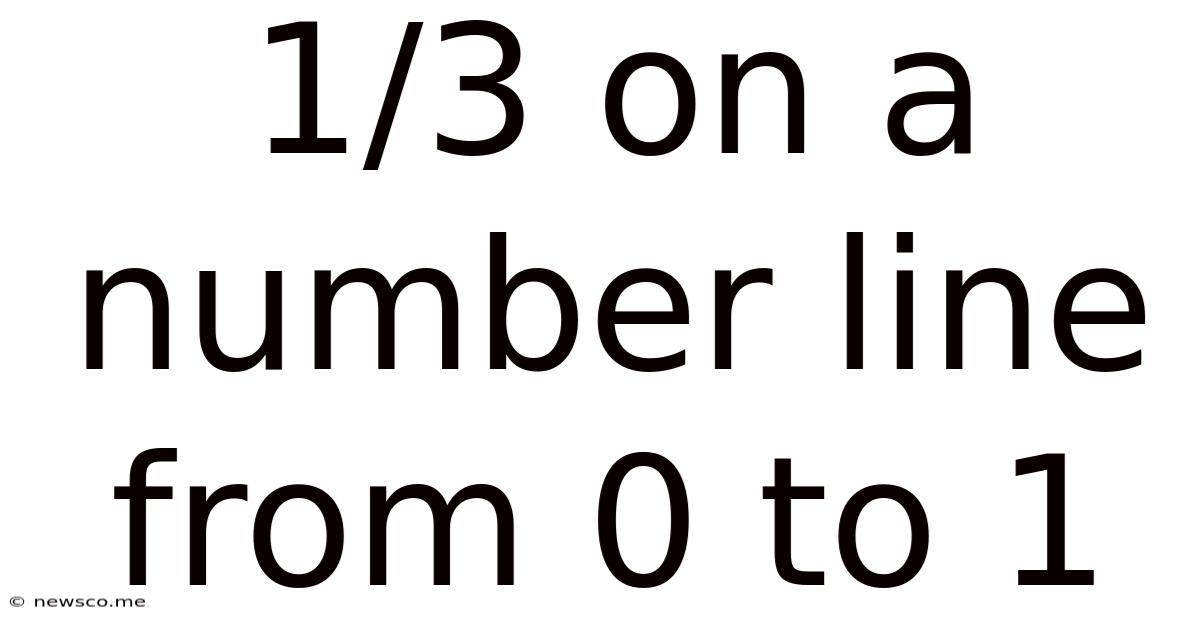1/3 On A Number Line From 0 To 1
News Co
Apr 25, 2025 · 5 min read

Table of Contents
1/3 on a Number Line: A Comprehensive Exploration
Understanding fractions is fundamental to grasping mathematical concepts. This article delves deep into the representation of the fraction 1/3 on a number line, exploring its significance, various methods of plotting it, and its implications in broader mathematical contexts. We'll move beyond simple plotting and examine the conceptual understanding behind its position, exploring related fractions and decimals, and touching upon its applications in real-world scenarios.
Understanding the Number Line
The number line is a visual representation of numbers, extending infinitely in both positive and negative directions. Zero (0) is the central point, with positive numbers increasing to the right and negative numbers decreasing to the left. This simple yet powerful tool allows us to visualize the relative positions and magnitudes of numbers, including fractions and decimals.
Key Features of a Number Line:
- Zero Point: The origin, separating positive and negative numbers.
- Positive Numbers: Located to the right of zero.
- Negative Numbers: Located to the left of zero.
- Equal Intervals: The distance between consecutive whole numbers is consistently maintained. This consistent spacing is crucial for accurately placing fractions.
Locating 1/3 on the Number Line from 0 to 1
The fraction 1/3 represents one part out of three equal parts of a whole. To locate it on a number line segment from 0 to 1, we need to divide the segment into three equal parts.
Method 1: Visual Division
- Draw the Number Line: Draw a straight line and mark the points 0 and 1.
- Divide into Equal Parts: Visually divide the segment between 0 and 1 into three equal sections. This requires careful estimation and precision.
- Locate 1/3: The first mark after 0 represents the fraction 1/3.
Visual representation:
0---|---1/3---|---2/3---|---1
While visually intuitive, this method relies on accurate estimation and might lead to slight inaccuracies.
Method 2: Using a Ruler
For greater accuracy, a ruler can be used.
- Measure the Segment: Measure the distance between 0 and 1 on your number line.
- Divide the Measurement: Divide the measured length by 3.
- Mark the Points: Using the calculated length, mark the points representing 1/3 and 2/3 on the number line.
This method provides higher accuracy compared to visual estimation.
Method 3: Mathematical Calculation
A more precise and mathematically sound approach is to utilize the decimal equivalent of 1/3.
- Convert to Decimal: 1/3 is equivalent to 0.333... (a repeating decimal).
- Locate on Number Line: Position the point slightly beyond 0.3 on the number line, acknowledging the repeating nature of the decimal.
This method offers a clearer understanding of the fractional value in relation to its decimal representation.
Understanding the Significance of 1/3 on the Number Line
Plotting 1/3 accurately on the number line reinforces several key mathematical concepts:
- Fractions as Parts of a Whole: It visually demonstrates that 1/3 represents one of three equal parts of the whole (the segment from 0 to 1).
- Decimal Equivalents: It highlights the relationship between fractions and decimals, showing that 1/3 is equivalent to 0.333...
- Relative Position: It emphasizes the relative position of 1/3 in relation to other fractions and numbers on the number line. For instance, it is less than 1/2 but greater than 0.
Extending the Concept: Related Fractions and Decimals
Understanding 1/3 on the number line provides a strong foundation for understanding other related fractions and decimals.
Related Fractions:
- 2/3: Represents two out of three equal parts. Located twice the distance from 0 as 1/3.
- 3/3: Equivalent to 1, representing the entire segment from 0 to 1.
- 4/3: Greater than 1, located one-third beyond 1 on the number line.
Related Decimals:
- 0.333...: The repeating decimal equivalent of 1/3. Illustrates the limitations of representing certain fractions as terminating decimals.
- 0.666...: The repeating decimal equivalent of 2/3.
- 1.0: The decimal equivalent of 3/3 or 1.
Real-World Applications of Understanding 1/3
The concept of 1/3, and its representation on the number line, has numerous real-world applications:
- Measurement: Dividing objects or quantities into thirds (e.g., cutting a pie into three equal slices).
- Cooking: Following recipes that require fractional measurements.
- Construction: Measuring and cutting materials accurately.
- Data Analysis: Representing proportions or percentages in charts and graphs.
- Probability: Calculating probabilities in scenarios with three equally likely outcomes.
Advanced Concepts: Irrational Numbers and Density
While 1/3 can be represented on the number line, its decimal representation highlights the existence of irrational numbers, which cannot be expressed as a simple fraction. The number line's density (the infinite number of points between any two points) implies the existence of an infinite number of other fractions and irrational numbers between 0 and 1.
Conclusion: Mastering Fractions through Visualization
Understanding the representation of 1/3 on a number line extends beyond mere plotting; it fosters a deeper comprehension of fractions, their decimal equivalents, and their role in broader mathematical concepts. The ability to accurately visualize and manipulate fractions on a number line is a crucial skill applicable across various fields, reinforcing the importance of mastering this fundamental mathematical concept. The techniques detailed in this article – visual division, ruler measurement, and mathematical calculation – offer multiple pathways to achieve accurate and meaningful representation of 1/3 on the number line, leading to a stronger overall grasp of numerical relationships. This deeper understanding empowers individuals to tackle more complex mathematical challenges with greater confidence and efficiency.
Latest Posts
Related Post
Thank you for visiting our website which covers about 1/3 On A Number Line From 0 To 1 . We hope the information provided has been useful to you. Feel free to contact us if you have any questions or need further assistance. See you next time and don't miss to bookmark.